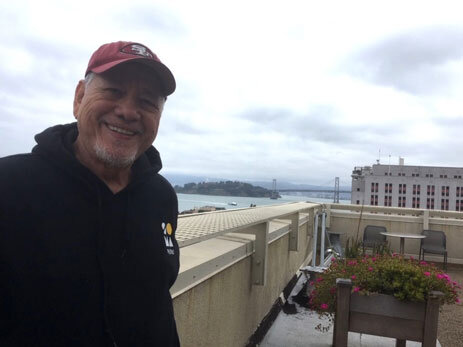The Manilatown Heritage Foundation Rises
/International Hotel Manilatown Center Today. Photo courtesy of Manila Heritage Foundation
The I-Hotel, located between Chinatown and what was then Manilatown (a three-block radius around the hotel’s location), housed elderly Asian residents. Manilatown thrived between the 1920s and late 1970s, and was home to businesses that catered to the Filipino community.
Gentrification triggered by city initiatives designed to push out minorities out of the area led to the eviction of the I-Hotel elderly tenants. Activists fighting for the I-Hotel tenants’ rights tried to fight eviction by the City for nine years but lost the battle the day San Francisco sent a troop of 300 policemen on horseback to move the tenants out by force. Although there were about 3,000 protesters who locked arms and barricaded the hotel, the altercation with the police turned violent. Protesters were beaten with batons, doors to apartments were hacked down with axes, and the elderly tenants finally surrendered.
Two years after the eviction, the I-Hotel was demolished to make way for a parking lot – but it was never built on, and the lot remained gutted for 26 years. In the meantime, the evicted elderly were permanently displaced – some of them moved in with relatives, others left San Francisco to places where they could live for less rent, and others remained homeless.
1977 International Hotel Eviction – Protesters blocking San Francisco police officers from evicting elderly tenants. Photo courtesy of Manila Heritage Foundation
Emil de Guzman, head of the I-Hotel Tenants Association at that time, recalls the long fight from 1968 when the eviction process began through that fateful day in 1977. A photo of him being dragged and manhandled by the SF Police who broke up the protest during the eviction became a symbol of the lost fight for the tenants’ rights and the end of Manilatown. The event is covered in a documentary called “How San Francisco Erased a Neighborhood” at https://www.youtube.com/watch?v=tcsdglJFT0M.
Emil de Guzman being dragged out of the I-Hotel by SF Policemen during the 1977 eviction. Photo courtesy of Emil de Guzman
But like a phoenix rising from its ashes, the new International Hotel was slated for construction by virtue of a US Department of Housing and Urban Development (HUD) act signed by then President Bill Clinton in 1994 to facilitate development of low-income housing. The vacant lot was up for purchase as a location for low-income housing. De Guzman noted that with St. Mary’s school in Chinatown being damaged by the 1989 Loma Prieta earthquake, there was a need for a new site. The Archdiocese of San Francisco purchased the lot to set the new location for St. Mary’s School.
“Although Manilatown no longer existed, we wanted to build a cultural center where Filipinos can gather to keep the legacy of our existence there alive,” according to De Guzman. “Together with Bill Sorro and Al Robles, we founded the Manilatown Heritage Foundation (MHF) in 1996 to help negotiate for ownership of space in the property where we could build this community center.”
(L to R): Manila Heritage Foundation founders Emil de Guzman, Al Robles and Bill Sorro. Photo courtesy of Emil de Guzman
With talks among members of the community, HUD, the Archdiocese and other organizations, the MHF was granted permission to occupy the first floor of the new International Hotel after its completion in August 2005. I-Hotel, with 104 units of senior housing (available by a lottery system), rises above the Manilatown Center. Manilatown in this neighborhood may not have survived the 1977 eviction, but the establishment of Manilatown Center keeps the legacy of San Francisco’s Manilatown neighborhood and the history of the 1977 International Hotel Eviction very much alive.
When asked why there are only a few Filipinos living currently in I-Hotel, De Guzman states that many of the displaced former tenants were able to return as residents, but times have changed and there are fewer Filipinos living now in the surrounding North Beach and Chinatown areas.
International Hotel activists reuniting decades after. L to R: Frank Celada, Bill Sorro, Al Robles, Teresita Peña and Emil de Guzman. Photo courtesy of Manila Heritage Foundation
As the I-Hotel Manilatown Center remains a memorial to the I-Hotel struggle, it also serves as a place for the community to gather for artistic, educational, and creative expressions relevant to today’s society. It survives with contributions from private citizens like Silicon Valley’s venture capitalists Mr. and Mrs. Dado Banatao, and other known community leaders like Shirley Ancheta, Vangie Buell, Estella Habal, Sonia Delen, Emil de Guzman, just to name a few. For a complete list of donors and supporters, see: https://manilatown.org/ways-to-help/.
Manilatown has gone through many changes, with its new leaders and staff under its new President Eleanore Fernandez and Executive Director Caroline Cabading. Under Cabading’s leadership the organization has increased its income and programming capacity through a combination of social enterprises, crowdfunding campaigns and grant awards from California Arts Council, San Francisco Arts Commission (SFAC) and the like.
Eleanore Fernandez, Board President. Photo courtesy of Manila Heritage Foundation
The Current Manila Heritage Foundation Staff (L to R): Jibril Alvarez, Chet Canlas, Sheryl Fontanilla, Marielle Concejo, Caroline Cabading, Carlos Zialcita, and Tony Remington. Photo courtesy of Jibril Alvarez
How Do You Keep The Music Playing?
Apart from the yearly commemoration of the I-Hotel eviction, the center provides cultural activities throughout the year with a combination of music, film, politics, and education. Most of its events have back stories that are just as interesting as the programs themselves.
Things got jazzed up a bit when Carlos Zialcita joined the Board of Directors of MHF. A teacher and Fil-Am historian, Zialcita joined Manilatown’s Board of Directors as its gatekeeper to help keep things running as MHF was starting to rev up its role as an active community center.
Zialcita lives and breathes jazz, and at the time the SF Fil-Am Jazz Festival, where he served as Executive Director, was struggling financially, Manilatown provided a venue where he could continue to keep the music playing for jazz aficionados. He saw a golden opportunity to provide free live jazz (and bits of Fil-Am historical notes) to the public with his fellow musicians right in the center of San Francisco. Club Mandalay, a weekend music event that turns the center into a jazz café, was born.
The Importance of Filipino Films in the Filipino-American Community
Enter fellow historian, poet, writer, teacher, and friend Oscar Peñaranda, a founding member of the Filipino American National Historical Society in San Francisco. Peñaranda makes frequent trips to the Philippines to fulfill lecture and workshop invitations, but being from a family engaged in the publishing and film industries, he connected with the Cinemalaya Film Festival organizers. He met with independent film directors whose movies he helped promote back in the US. The Cinemalaya Film Festival, whose aim is the development and promotion of Filipino independent films, is held annually during the month of August at the Cultural Center of the Philippines Complex and various cinemas. Bringing the idea of promoting these Filipino filmmakers in San Francisco as a way of bridging the gap between Filipinos born in opposite sides of the world, Peñaranda teamed up with Zialcita and Cabading who opened “Manila Movietime” as a regular film and educational event in Manilatown since 2019.
Oscar Peñaranda enjoying the San Francisco skyline view from the International Hotel rooftop. Photo courtesy of Oscar Peñaranda
ZOOM Panelists for “Ganito Kami Noon, Papaano Kayo Ngayon”- (L to R) Top: Reuniting cast Joey Romero, Adelaide Lim and Eddie Rocha. Bottom: ABS-CBN Film Restoration Team members Leo Katigbak and Julie Galino. Virtual event postcard by Jeanette Vives
Manila Movietime does not only show Cinemalaya film, but also Filipino classics, like “Ganito Kami Noon, Papaano Kayo Ngayon,” which was presented recently by MHF in partnership with ABS-CBN’s The Filipino Channel. ABS-CBN, the largest broadcasting company in the Philippines, has overseen the restoration of almost 200 classic Filipino films through “Sagip Pelikula,” its film restoration archive team headed by Leo Katigbak.
After the film showing, a panel of the film’s cast and the restoration crew joined host Zialcita and Peñaranda, who moderated a dynamic discussion of the film production and recent restoration process. The event was also a reunion of the cast who had not seen each other since they worked together over 40 years ago, according to Peñaranda. The cast members Joey Romero, son of the late writer and director Eddie Romero, Eddie Rocha, and Adelaide Lim, were just finding their niche in acting and film production at the time of the filming. They are now leaders in the entertainment industry and mentor the younger generation in the Philippines. Katigbak’s team had consulted with Romero regarding his father’s work as the restoration team worked on this film.
When a film is followed by a discussion and guest panelists talk about the essence or message of the filmmaker and other nuances of a movie, they usually become a source of gold nuggets of information for the viewers. The recently shown panel discussion turned out more than nuggets, it was a gold mine of more back stories that moviegoers usually soak up to enhance their viewing experience. It was like a master class in filmmaking and a remarkable introduction to Filipino film archiving and restoration provided by Katigbak and film archive manager Julie Galino, who used to work as a technical specialist for restoration for LVN Pictures, Inc.
Cultural Events
A Filipino center will not be complete without an offering of traditional Philippine music, dance, and cultural education programs. Kommunity Kultura is not only educational, but is also a feast for the senses as music and movement from pre-colonial traditions are explored with experts in ethnic studies and performing arts. This program also offers family-friendly workshops, oftentimes hands-on, and are accessible to all ages and levels of ability. This is where the center transforms into a stage, classroom or art exhibit gallery.
Upcoming Event: Kommunity Kultura at Manilatown Heritage Foundation
With the pandemic still hovering in our midst, Manilatown is going virtual with its heritage preservation work – definitely a grand opportunity for all to take a look at a group of Filipino-Americans who make history, music, social awareness, civil rights activism and lives matter.
Manzel Delacruz is a freelance writer living in San Francisco.
More articles from Manzel Delacruz













